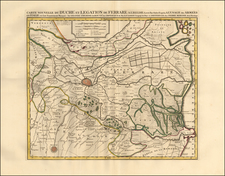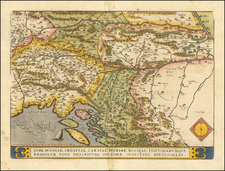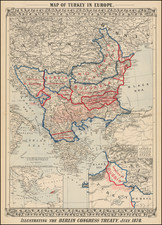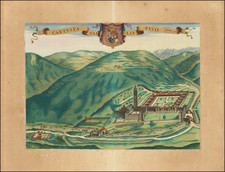Mercator's map provide an intricate view of a region, covering Istria, Slovenia, Northern Croatia, the Gulf of Venice, and the Gulf of Trieste.
The map encompasses modern-day Slovenia, northwestern Croatia, and the parts of Friuli-Venezia Giulia in Italy.
Karstia: Encompassing the region around the Karst Plateau, this area, known for its unique limestone topography, was under the Habsburg Monarchy in the 17th century. The century was marked by tensions between the Protestant Reformation and Catholic Counter-Reformation, leading to various skirmishes and power dynamics within the region.
Carniola (Kranj in Slovenian): Modern-day central Slovenia, Carniola was a crown land of the Habsburg Monarchy. Throughout the 17th century, the Habsburgs sought to strengthen their hold over Carniola, especially amidst the backdrop of the Thirty Years' War (1618-1648). It was a time of religious strife as Protestantism took hold in parts of the region, only to be suppressed later by a resurgence of Catholicism, backed by the Habsburgs.
Histria (Istria): The Istrian Peninsula, jutting out into the Adriatic Sea, was contested territory in the 17th century. The Republic of Venice held considerable sway in the western part of Istria, while the Habsburgs controlled the eastern portions. As Venice's power waned towards the end of the 17th century, Habsburg influence grew stronger. The strategic location of Istria made it a significant maritime and trade gateway, with its control seen as pivotal to exerting power in the Adriatic.
Windorum Marchia (The March of the Windic): This region roughly corresponds to Lower Carniola, present in modern-day southeastern Slovenia. The 17th century for Windorum Marchia, much like Carniola, was marked by religious tensions and Habsburg consolidation, especially after the effects of the Thirty Years' War.
during the mid-17th century would have included a number of significant towns and cities, reflecting the cultural, trade, and strategic priorities of the time. Here are some of the major ones:
- Ljubljana (Laibach): Now the capital of Slovenia, Ljubljana has been a cultural, political, and economic center for centuries. In the context of the 17th century, it would have been one of the most notable cities in Carniola.
- Trieste: Located near the border of Italy and Slovenia, it is a port city on the Adriatic Sea. Under Habsburg rule during the 17th century, Trieste became a key port and commercial hub, further rising in importance in subsequent centuries.
- Koper (Capodistria): Located in Istria, this port city was under Venetian control for much of its history. It was a vital maritime and trade point in the Adriatic.
- Piran (Pirano): Another significant city in Istria, Piran, also had a long history of Venetian influence and was known for its maritime activities. It is now at the center of the 29 mile Slovenian Adriatic coastline.
- Novo Mesto: Located in the region of the March of the Windic (Windorum Marchia), it’s an important city in southeastern Slovenia and played a role in regional trade.
- Gorizia (Görz): While slightly to the west of the main map's focus, this town was important in the broader region, marking a point of cultural and political blend between Slavic and Italian influences.
- Postojna: Known for its vast cave system, Postojna was a significant town in the Karst region.
- Rijeka (Fiume): Now part of Croatia but historically tied to both Croatia and Hungary, Rijeka was another crucial Adriatic port, serving as a key trade and naval point for various empires.
- Pula (Pola): Located at the southern tip of the Istrian peninsula, Pula, with its ancient Roman amphitheater, was another city under Venetian influence.
- Krško: A town in the Lower Carniola region, it was an essential point along the Sava River.
Throughout the 17th century, these regions were greatly influenced by wider European events. The Habsburg Monarchy, in its fight against the Ottoman Empire, often involved these territories directly or indirectly. The Thirty Years' War, though primarily a Central European conflict, echoed in the policies and religious shifts in these areas. The ebb and flow of Venetian power, coupled with the rise of the Habsburgs, shaped the geopolitical realities of Istria.

![[ Istria / Croatia / Slovenia / Fruili ] Forum Iulium Karstia, Carniola Histria et Windorum Marchia By Gerhard Mercator](https://storage.googleapis.com/raremaps/img/small/61612.jpg)








![[ Lazio ] Campagna di Roma, olim Latium: Patrimonio Di S. Pietro; et Sabina](https://storage.googleapis.com/raremaps/img/small/98622.jpg)




